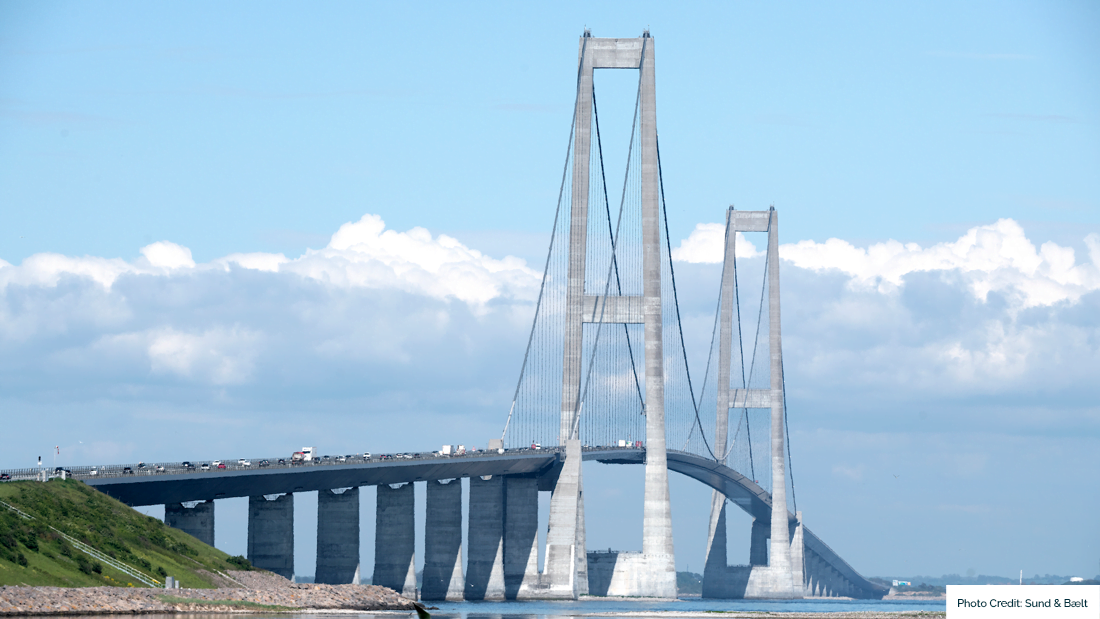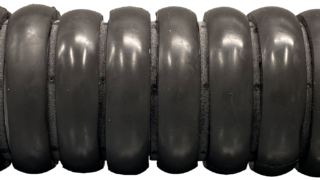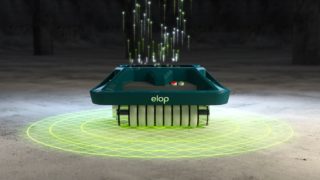Inspection drones, artificial intelligence and 1000+ sensors are part of the complex Asset Management system that will extend the lifetime of the Danish Storebæltsbroen to 200 years, while drastically reducing its maintenance cost and CO2 impact.
Proactive maintenance is a trend that spans many industries and domains: Asset owners and managers leave the traditional paradigm of scheduled and reactive maintenance of assets, and work towards performing maintenance based on the actual condition of the assets.
To make that transition, continuously monitored data is needed to be fed into an Asset Management system, which enables setting up a condition-based, preventive maintenance program.
The potential of such Asset Management systems for large public infrastructures, like bridges and tunnels, is huge. But globally, so far only a handful of asset owners have dedicated themselves fully to developing such systems. One of them is based in Denmark. It’s the organization managing the 17 km tunnel/bridge link across the Storebælt strait. To highlight what can be achieved when you harness the power of data to optimize the maintenance of such a large asset, let’s take a closer look at how Sund & Bælt, the organization responsible for the maintenance of Storebæltsbroen, the world’s 3rd largest suspension bridge, is approaching the concept of data-driven, condition-based maintenance.
Reducing environmental impact
Before focusing on the nuts and bolts of the Storebæltsbroen Asset Management system, here are a few numbers and facts about what it is achieving: It will double the lifetime of the bridge from 100 to 200 years. Due to the prolonged lifetime, the CO2 impact of the bridge will be reduced with 750.000 tons over 100 years. Furthermore, maintenance cost has been reduced significantly, and will be kept at that level, although the bridge is growing older and will need more attention in the future.
Bjarne Jørgensen, CTO of Sund & Bælt explains:
- About 4 years ago we decided to change our maintenance setup from time-based, reactive maintenance to a digital, condition-based Asset Management system. In our context, assets are pumps, ventilators, bridge piers, hanger cables, and all the other parts that make up a bridge and a tunnel.
- We looked at the aviation and automotive industries and we saw that in these domains it was substantially cheaper to run and maintain plants, infrastructures and machines when doing preventive and predictive maintenance instead of doing it the traditional, time-based way. So, we thought that this approach would work with a tunnel and bridge as ours as well. That was the starting point.
According to Bjarne Jørgensen, two factors were crucial to making such a transition. Firstly, better and more detailed knowledge about the condition of each asset was needed. Secondly, a maintenance system to collect the data had to be developed.
To gather the required data, 1000+ sensors were deployed across the entire structure, to supplement the regular manual inspections. To develop the maintenance system, Sund & Bælt engaged with IBM to further develop its Maximo system for management of non-information technology assets, to be able to integrate the digital tools monitoring different aspects of the bridge.
Measuring vibration of hanger cables
As an example, sensors are monitoring the hanger cables going from the bridge’s main cable to the bridge deck. They measure the vibration and the movement of the cables, caused by wind and heavy vehicles. These cables, weighing 10 tons each, were initially predicted to last 50 years before having to be replaced. But increasing traffic and changing weather conditions may put additional strain on them and affect their integrity. To keep them under close observation Bjarne Jørgensen and his team have developed digital twins, enabling engineers to assess the effect of changing conditions and to calculate the exact right time for replacement.
- At the same time, we were looking for ways to replace manual inspections, which are time-consuming and expensive, with digital tools. Sensors can do a substantial part of that job, and to supplement the sensor data we developed an automated visual tool, consisting of camera drones taking pictures of the concrete surfaces. We have 300.000 square meters of concrete that we must inspect every six years. Previously we hired climbers for this. Now we send out our drones and the system analyses the images with artificial intelligence. If the system discovers anything suspicious it sends it to an engineer for assessment. This solution is both cheaper and more precise, and we’re now considering doing the drone inspection on a yearly basis, instead of every six years, as the regulations require.
Reduced safety margins
Another aspect is, according to Bjarne Jørgensen, that with a more detailed knowledge of the condition of individual components, you can reduce safety margins. While you previously had to replace an item in good time before it was predicted to fail, just to be on the safe side, you now can assess its current condition more precisely and thus prolong its lifetime. According to Bjarne Jørgensen, this has contributed to the reinvestment budget of Storebæltsbroen decreasing 40 per cent, compared to the initial estimate made when the bridge was put into operation in 1998.
Prolonged lifetime
At that time, specialist engineers from the Danish engineering company Rambøll calculated the expected lifetime of the bridge. They predicted it to last 100 years. Now, Rambøll has done a new calculation, based on the improved maintenance regime, and now predicts it to last 200 years. This not only improves the economic efficiency of the bridge, but also reduces its CO2 impact significantly, as 40 per cent of its carbon footprint is related to its construction. According to Rambøll, the CO2 impact of the bridge will be reduced with 750.000 tons over 100 years.
- To sum up the benefits of our digital transition, we are getting a 15 to 25 per cent increase in productivity, a 30 per cent reduction in time for risk assessment, and a 100 per cent increase in lifetime.
The Storebæltsbroen digital transformation project was launched in 2017 and will be completed by the end of 2022. Currently, data from different sensors are being integrated into the system, together with new tools helping maintenance workers plan their workday and improve logistics and reporting. Developed by Sund & Bælt together with IBM, the system is marketed worldwide by IBM under the name Maximo for Civil Infrastructure.
Asset Management on the rise
According to Bjarne Jørgensen, many asset owners like Sund & Bælt are working with Asset Management. Some of them do it for the same reasons as Sund & Bælt, to optimize maintenance and reduce environmental impact. Others may not have been as thorough as they should have in monitoring and maintaining their asset and are now feeling the pressure from regulators and from the public to document that they are performing inspections and doing repairs according to regulations.
- However, only a handful have really committed to this transition and have invested the resources needed to develop a system that is as detailed as necessary to make a difference in the day-to-day operations of a large asset. One of the reasons is, I believe, that currently there are no Asset Management Systems on the market, tailor-made for asset owners like us. When we took that strategic decision, we were aware that we were moving into the greenfield of digitalization, but we took that risk because we knew it was the right decision.
And Bjarne Jørgensen and his team is prepared to go even further. Apart from managing the Storebæltsbroen, Sund & Bælt carries half the responsibility for maintaining the Øresundsbron link between Copenhagen and Malmø and is currently preparing the construction of the world’s longest submerged tunnel, going across Fehmarn Belt.
The Fehmarn project will in Bjarne Jørgensens opinion be a golden opportunity to design an optimal sensor infrastructure for monitoring and make it an integral part of the tunnel.
- Based on our experience from the tunnel part of Storebæltsbroen, we know what measurements we need and what type of feedback we would like to get from the new tunnel. This means we have ideal conditions to design the future Fehmarn Belt Asset Management system.
Data on the condition of concrete is a key in predictive maintenance
ELOP Technology strongly believes in the philosophy of predictive maintenance. That is why the company has developed an ultrasound inspection tool to produce data on the condition of large concrete structures, as precisely and efficiently as possible.
Together with data from other sources, ELOP Insight data can be fed into Asset Management systems, that give asset owners a detailed overview of the condition of a bridge, tunnel, dam or any other structure. To develop such systems, ELOP is engaging in several research and development collaborations. Currently ELOP is working with the leading Scandinavian construction and engineering company Veidekke to develop an Asset Management system for Stavangerregionen Havn IKS, responsible for management of assets such as piers, jetties and buildings in the ports of the Stavanger region in Norway. Also, ELOP is partnering with the largest infrastructure owner in Norway, the Norwegian Public Roads Administration, to develop an IT tool for management of concrete structures.




